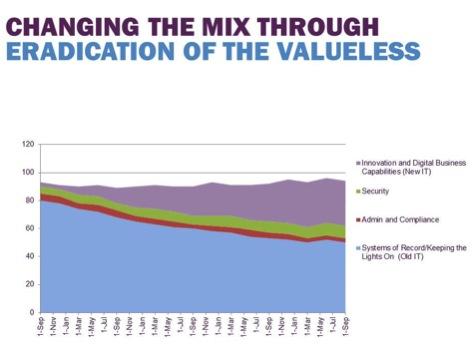11:30 AM
Old vs. New: The Difference in Banking IT Transformation
Nearly every company has a story about trying to transform its operations, coming up short because it lacked the IT bandwidth to finish the venture.
Unless you’re leading a brand-new company, your organization has history, and that includes expensive, valueless IT investments that bog down competitive advantages like agility. And when it comes to who has the most to gain, not every industry is the same.
The banking and financial services industry nearly tops the list of largest IT budgets, spending an average 6.3% of revenue on technology, according to the 2014 Gartner IT Key Metrics Data. It only slightly trails behind the software publishing and internet services industry, which spends 6.7% of revenue on IT.
The enemy, however, isn’t costs. It’s the value IT delivers. That’s the difference between “old IT” and “new IT.” Companies of any size can exploit transient competitive advantage using technology’s speed, ubiquity, and cost models -- as long as they’re unencumbered by valueless IT assets.
New business expectations -- better targeting, data analytics, a more agile business, just to name a few -- place IT in an unprecedented land of opportunity. Yet indecision or ignorance about changing the old IT operating model could create a crisis of survival.
Activities that “keep the lights on” consume precious resources. Eliminating valueless assets gives IT new-found time and capital to keep pace or even lead business innovation.
Think like a stockbroker. Data-driven buy-hold-sell management helps companies weed out unnecessary assets and focus on what furthers the business.
Discriminate between the valuable and valueless like a stockbroker
Digital capabilities offer nearly limitless promise. However, funds and talent to deliver them do have limits. Some IT organizations allocate more than 80% of their budgets and talent to maintain the status quo. It’s easy to see why there isn’t the bandwidth to support innovation through technology.
But significant change can be made. For example, one financial services firm with a $4 billion IT budget unified its business and IT strategies with a focus on optimizing its application portfolio. The move not only reduced technological complexity, but also freed 15% of its IT budget.
The firm used a systematic, fact-based approach that can be replicated by other banking and financial services organization. By using business and IT metrics, leaders are encouraged to think like a stockbroker and categorize existing IT assets into a buy-hold-sell portfolio.
“Buy” refers to applications needed to grow the business. “Hold” reflects necessary applications that don’t require investment beyond their value. Lastly, “sell” points to apps that deplete resources and budgets without contributing to the organization.
At minimum, business and IT unify around the things that matter most -- capital, talent, and projects are allocated to “buys.” From there, IT can starve the “sells” through enterprise-wide transparency.
Before buy-hold-sell: Graph shows the timeline breakout of 80% “keeping the lights on,” 6% admin, 4% security, 5% compliance, and 4% innovation
After buy-hold-sell: Graph shows the timeline breakout of 60% “keeping the lights on,” 6% admin, 10% security, 5% compliance, and 17% innovation.
(Chart data describes concept; does not reflect specific figures or actual data. Credit: KillerIT)
Agility of the lean
As companies identify and eliminate valueless IT assets through buy-hold-sell management, the IT operating model becomes focused, lean, and more efficient. Business leaders will feel the operational agility of business and IT unified around things that matter most. New business capabilities will be delivered with the speed, accuracy, and cost structure of a unified enterprise.
The IT investment yield curve quickly springs from a flat formation to a steeper, yield -- more representative of a digital company. This is true, sustainable transformation.
Organizations that can deliver five times or 10 times the business capabilities per cost unit are operating with the desired steep operating model yield of a digital company. These are companies, irrespective of size, capable of delivering a disruptive, digital knock-out blow to incumbent businesses operating with flat, old IT operating models.
As IBM’s Chief of Innovation Bernie Meyerson has said, “Those who stop innovating disappear.”
Shaking IT up
Some companies have seen as much as $200 million in savings over the course of 12 months, just by categorizing and rationalizing their applications. Like an investor looking to buy, hold, or sell, the right decisions can make your application portfolio the catalyst for a new IT operating model.
Shedding the weight and complexity of unnecessary applications leaves a company with more money and greater bandwidth to focus on priorities beyond just maintaining operations, fostering innovation.
The impact is clear. Embrace the power of the new IT operating model and drive digital innovation so your company not only survives but thrives.
Bob is Founder and President of KillerIT. He is responsible for KillerIT's strategic direction and execution. During Bob's 25 years at Forsythe Technology, he has held a number of national management positions and earned numerous distinctions. Most recently, he was senior ... View Full Bio




















